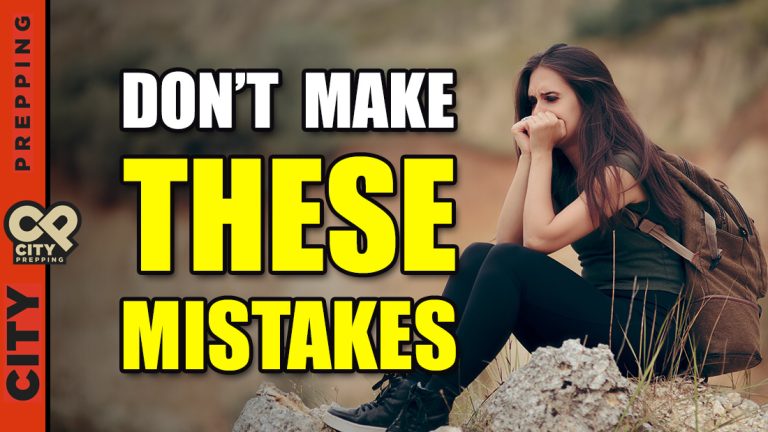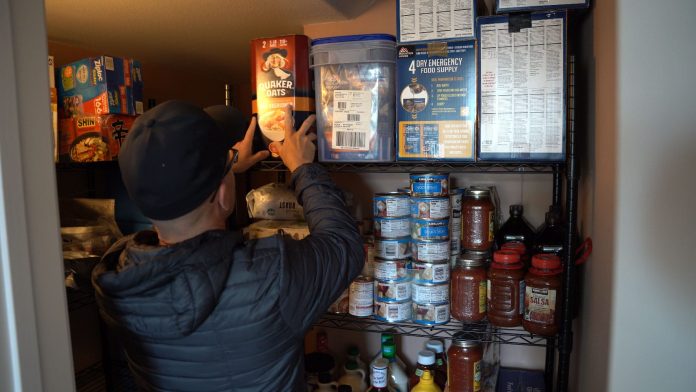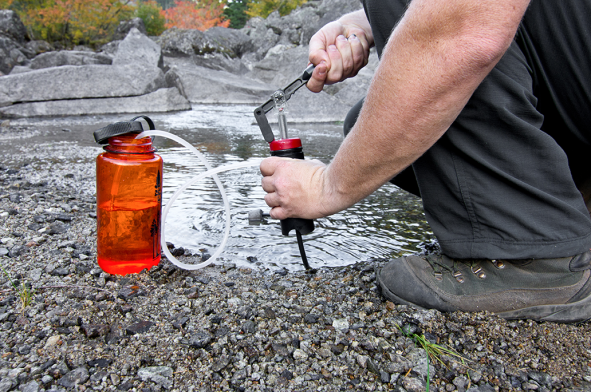 The most apparent reason why bugging out is a bad idea is because you have to leave your preps behind. You may have a 55-gallon barrel or two of water in your garage for an emergency, but that 55-gallon barrel will weigh at least 484 pounds or 220 kilograms. It’s far too heavy to move quickly, load into a vehicle, or even roll down the street. Just a gallon of water weighs 8.34 pounds or 3.785 kilograms. Just carrying 3-gallons will make movement difficult for you. Your other option is collecting water from the wild and treating it to be drinkable. You could use a Silcock key to harvest water from commercial buildings or use a LifeStraw or other personal filtration device for drinking water from the wild. However, the problem is that when you are on the road and fleeing a disaster, the competition for water and other resources will be high. You may be targeted or robbed at worst. At best, you may be competing for water sources.
The same is true for food. Fortunately, you can carry enough of the right foods to sustain you a long time, but the decision to abandon your neat shelves and well-stocked pantry is difficult. When many people are fleeing a disaster, any prepackaged or commercial food sources will be depleted from the environment within a few hours or days. The food you are carrying may make you a target, just like water would. If you are forced to bug out, there are three keys to your food security. First, make sure that at least some of your food preps are hidden and not discoverable to anyone who may break into your home while you are fleeing the disaster zone. You may end up circling back to your location when the environment is safe again. While people trying to survive might raid your pantry, they aren’t likely to go into your attic space, crawl space, or dig up your hidden cache in your backyard. This will give you better odds of coming home to preps you’ve stored. Second, know how to forage. If you can grab food along your way, if you understand the plants in your area, you will be able to supplement your calories and nutrient diversity. This can keep you moving. Knowing a handful of plants you can safely consume could mean the difference between life and death. Know where these food resources are along the route to your bugout location. 90% of people will walk right by wild sunflowers, Curly Dock, Dandelions, wild onions, Chickweed, Broadleaf Plantain, rosehips, yarrow, even Canna Lily tubers. Walk your bugout route now, and know where various food sources are located in plain sight.
Some of your equipment you can take with you. Some you will have no choice but to leave behind. You may have an arsenal, but you won’t be able to carry it all nor walk down the street with it if government resources are deployed. You might not be able to carry a generator if you are on foot. You might not be able to carry much of the equipment you would use in your home location. This is where a bugout bag is crucial. It has to be light enough to maintain mobility and speed, but it also has to have all the essentials you will need to compensate for what you have to leave behind.
2) Your Odds of Survival Decrease
The most apparent reason why bugging out is a bad idea is because you have to leave your preps behind. You may have a 55-gallon barrel or two of water in your garage for an emergency, but that 55-gallon barrel will weigh at least 484 pounds or 220 kilograms. It’s far too heavy to move quickly, load into a vehicle, or even roll down the street. Just a gallon of water weighs 8.34 pounds or 3.785 kilograms. Just carrying 3-gallons will make movement difficult for you. Your other option is collecting water from the wild and treating it to be drinkable. You could use a Silcock key to harvest water from commercial buildings or use a LifeStraw or other personal filtration device for drinking water from the wild. However, the problem is that when you are on the road and fleeing a disaster, the competition for water and other resources will be high. You may be targeted or robbed at worst. At best, you may be competing for water sources.
The same is true for food. Fortunately, you can carry enough of the right foods to sustain you a long time, but the decision to abandon your neat shelves and well-stocked pantry is difficult. When many people are fleeing a disaster, any prepackaged or commercial food sources will be depleted from the environment within a few hours or days. The food you are carrying may make you a target, just like water would. If you are forced to bug out, there are three keys to your food security. First, make sure that at least some of your food preps are hidden and not discoverable to anyone who may break into your home while you are fleeing the disaster zone. You may end up circling back to your location when the environment is safe again. While people trying to survive might raid your pantry, they aren’t likely to go into your attic space, crawl space, or dig up your hidden cache in your backyard. This will give you better odds of coming home to preps you’ve stored. Second, know how to forage. If you can grab food along your way, if you understand the plants in your area, you will be able to supplement your calories and nutrient diversity. This can keep you moving. Knowing a handful of plants you can safely consume could mean the difference between life and death. Know where these food resources are along the route to your bugout location. 90% of people will walk right by wild sunflowers, Curly Dock, Dandelions, wild onions, Chickweed, Broadleaf Plantain, rosehips, yarrow, even Canna Lily tubers. Walk your bugout route now, and know where various food sources are located in plain sight.
Some of your equipment you can take with you. Some you will have no choice but to leave behind. You may have an arsenal, but you won’t be able to carry it all nor walk down the street with it if government resources are deployed. You might not be able to carry a generator if you are on foot. You might not be able to carry much of the equipment you would use in your home location. This is where a bugout bag is crucial. It has to be light enough to maintain mobility and speed, but it also has to have all the essentials you will need to compensate for what you have to leave behind.
2) Your Odds of Survival Decrease
 The minute you step out the door and abandon your location, your odds of survival plummet. Even if you have a bugout bag, hundreds if not thousands of people around you will not be so well prepared. They will all be competing for resources, and you are a target with a backpack full of resources. You have to move fast with as much stealth as possible and away from any concentrations of people. That is difficult because people will be clogging whatever pathways away from the disaster zone exist. Desperation can turn even the most civil of people into barbarians.
Beyond your personal security, your odds of survival decrease because of the environment. The aftermath of a disaster is often worse than the initial disaster. While a hurricane may pass, the toxic floodwaters left behind can cause severe health problems to you just by wading through them. Poisonous chemicals and sewage will mix with the floodwaters and even render your garden inedible for a time. Debris, destroyed and damaged buildings, fires, and more can all present immediate dangers. As if the aftermath isn’t enough to deal with, simply being in the elements can reduce your odds of survival. Although it varies depending on skin type, you can experience sunburn in a matter of minutes. After 20-minutes without sunscreen, it starts to get dangerous for many people. Without protection, several hours in the sun can give you sun poisoning, dehydration, exhaustion, blistered skin, and heatstroke. You may not use sunscreen every day, but you are also likely moving from your home to vehicle to office or store. Your actual direct exposure isn’t consistent. When you are on the road and bugging out, your constant exposure goes way past your average exposure. For this reason, you should make sure you have sunscreen and a hat in your bugout bag.
Long-term exposure to cold, wind, or water is also a hazard to you. Having a jacket, gloves, socks, rain gear, and decent walking or hiking shoes will put the odds of survival back in your favor. And that’s assuming you’re physically fit to move long distances with your gear.
3) Orderly Fashion
The minute you step out the door and abandon your location, your odds of survival plummet. Even if you have a bugout bag, hundreds if not thousands of people around you will not be so well prepared. They will all be competing for resources, and you are a target with a backpack full of resources. You have to move fast with as much stealth as possible and away from any concentrations of people. That is difficult because people will be clogging whatever pathways away from the disaster zone exist. Desperation can turn even the most civil of people into barbarians.
Beyond your personal security, your odds of survival decrease because of the environment. The aftermath of a disaster is often worse than the initial disaster. While a hurricane may pass, the toxic floodwaters left behind can cause severe health problems to you just by wading through them. Poisonous chemicals and sewage will mix with the floodwaters and even render your garden inedible for a time. Debris, destroyed and damaged buildings, fires, and more can all present immediate dangers. As if the aftermath isn’t enough to deal with, simply being in the elements can reduce your odds of survival. Although it varies depending on skin type, you can experience sunburn in a matter of minutes. After 20-minutes without sunscreen, it starts to get dangerous for many people. Without protection, several hours in the sun can give you sun poisoning, dehydration, exhaustion, blistered skin, and heatstroke. You may not use sunscreen every day, but you are also likely moving from your home to vehicle to office or store. Your actual direct exposure isn’t consistent. When you are on the road and bugging out, your constant exposure goes way past your average exposure. For this reason, you should make sure you have sunscreen and a hat in your bugout bag.
Long-term exposure to cold, wind, or water is also a hazard to you. Having a jacket, gloves, socks, rain gear, and decent walking or hiking shoes will put the odds of survival back in your favor. And that’s assuming you’re physically fit to move long distances with your gear.
3) Orderly Fashion
 Roads can quickly become clogged when you are part of the mass exodus out of a disaster zone. Police or military may want you to move along with the masses in an “orderly fashion.” They, of course, are trying to control the chaos, but being herded with everyone else may not be in your best interests. Your preps, even what little you carry in your pack, may be seized by the authority on charge. Your weapons for personal protection may be confiscated. You may be separated from your loved ones by age or gender. You could have your travel restricted until orders from above come, which may keep you in an unsafe environment. You could even be herded into a FEMA camp or safe zone when it would be better for you to get out of the area altogether.
Sometimes you are safer in the crowd. If you are prepped when others are not, that is usually not the case. Becoming a refugee or part of a group of civilians exiting an area does not necessarily increase your odds of survival. Every person who never bothered to prepare is also part of this group. Every stranger you would never associate with is thrown together and treated as a whole. You may be swept up into the horde, and forces beyond your control will be making decisions for the desperate group and not necessarily in your best interest. When bugging out, make haste and avoid crowds if at all possible. There is no such thing as an “orderly fashion” when people are desperate, panicked, and subject to a greater ruling force. Get to your primary or secondary bugout location and out of the disaster zone.
4) Lack of Skills
Roads can quickly become clogged when you are part of the mass exodus out of a disaster zone. Police or military may want you to move along with the masses in an “orderly fashion.” They, of course, are trying to control the chaos, but being herded with everyone else may not be in your best interests. Your preps, even what little you carry in your pack, may be seized by the authority on charge. Your weapons for personal protection may be confiscated. You may be separated from your loved ones by age or gender. You could have your travel restricted until orders from above come, which may keep you in an unsafe environment. You could even be herded into a FEMA camp or safe zone when it would be better for you to get out of the area altogether.
Sometimes you are safer in the crowd. If you are prepped when others are not, that is usually not the case. Becoming a refugee or part of a group of civilians exiting an area does not necessarily increase your odds of survival. Every person who never bothered to prepare is also part of this group. Every stranger you would never associate with is thrown together and treated as a whole. You may be swept up into the horde, and forces beyond your control will be making decisions for the desperate group and not necessarily in your best interest. When bugging out, make haste and avoid crowds if at all possible. There is no such thing as an “orderly fashion” when people are desperate, panicked, and subject to a greater ruling force. Get to your primary or secondary bugout location and out of the disaster zone.
4) Lack of Skills
 Surviving on the road isn’t easy, and people’s lack of skills will get them killed. Some people haven’t a clue about filtering water, starting a fire, building a shelter, or tying a knot. Just as they will walk by the food you can forage, they are helpless and desperate after a disaster strikes. You can’t save them all with even the most honed skills and bushcraft expertise. If you start a fire to cook some emergency rations or boil water, you will soon have every person within a mile radius heading your direction. That being said, fire is the greatest tool you will have available to you after a disaster. You may need to boil water, cook food, stay warm, even ward away wild animals. You should know how to start a fire without a lighter or matches, and the tools you will need must be in your bugout bag. I know from teaching cub scouts that you can have an excellent Ferro rod in your bugout bag, but if you have little to no experience starting fires with it, you won’t be able to create a fire after a disaster. Practice the skills until they are second nature to you. Having some basic bushcraft skills that aren’t just theory but you have put into practice on occasion will mean the difference between surviving or dying.
Even with careful rationing on your part, your supplies will eventually run out. As previously mentioned, know how to forage, how to start a fire, how to hunt and set a snare, how to process animals, how to find and render water drinkable, and how to build a few different types of simple structures. Practice all of these skills as often as you can. Even if you aren’t able to put the skill into practice, have a theoretical understanding of it. You might not ever set a bone and make a splint, but you should at least know how. You should know how to treat a wound or stop bleeding. You can take this a step further and get a practice suture kit and learn this vital skill. It could save your life or someone else’s. Water, fire, food, medical, and shelter are highly important essentials to surviving a bugout.
At the very least, learn what needs to be in your bugout bag. For instance, a tarp that may only cost a few dollars can mean the difference between surviving by building a structure or dying from exposure. Paracord can serve several functions, but if you don’t know how to tie more than a shoelace or square knot, it will be useless to you. It takes years to become experienced in bush crafting, but even knowing a little may be enough to keep you alive for a short period or long enough to figure the rest out.
5) Homefield Advantage
Surviving on the road isn’t easy, and people’s lack of skills will get them killed. Some people haven’t a clue about filtering water, starting a fire, building a shelter, or tying a knot. Just as they will walk by the food you can forage, they are helpless and desperate after a disaster strikes. You can’t save them all with even the most honed skills and bushcraft expertise. If you start a fire to cook some emergency rations or boil water, you will soon have every person within a mile radius heading your direction. That being said, fire is the greatest tool you will have available to you after a disaster. You may need to boil water, cook food, stay warm, even ward away wild animals. You should know how to start a fire without a lighter or matches, and the tools you will need must be in your bugout bag. I know from teaching cub scouts that you can have an excellent Ferro rod in your bugout bag, but if you have little to no experience starting fires with it, you won’t be able to create a fire after a disaster. Practice the skills until they are second nature to you. Having some basic bushcraft skills that aren’t just theory but you have put into practice on occasion will mean the difference between surviving or dying.
Even with careful rationing on your part, your supplies will eventually run out. As previously mentioned, know how to forage, how to start a fire, how to hunt and set a snare, how to process animals, how to find and render water drinkable, and how to build a few different types of simple structures. Practice all of these skills as often as you can. Even if you aren’t able to put the skill into practice, have a theoretical understanding of it. You might not ever set a bone and make a splint, but you should at least know how. You should know how to treat a wound or stop bleeding. You can take this a step further and get a practice suture kit and learn this vital skill. It could save your life or someone else’s. Water, fire, food, medical, and shelter are highly important essentials to surviving a bugout.
At the very least, learn what needs to be in your bugout bag. For instance, a tarp that may only cost a few dollars can mean the difference between surviving by building a structure or dying from exposure. Paracord can serve several functions, but if you don’t know how to tie more than a shoelace or square knot, it will be useless to you. It takes years to become experienced in bush crafting, but even knowing a little may be enough to keep you alive for a short period or long enough to figure the rest out.
5) Homefield Advantage
 The moment you step beyond your protective walls, you lose your home-field advantage. You become a stranger in a landscape that can be dramatically altered and treacherous. Your personal security is no longer afforded to you by your home shelter. Your resources are reduced to just what you can carry, and you become a competitor for minimal resources. You leave behind tools, equipment, food, water, medical supplies, and more. When you are bugging in, and a problem arises, you simply use the tools you have. When you are on the road, and a problem arises, you are exposed and often lack what you need. You go from efficiently handling issues to struggling to get by. Hydration, nutrients, and sleep are all a ticking clock for you that you must continually wind even as you struggle to keep moving. You don’t know where anything is that can help you, and the environment may have changed dramatically in the aftermath of a disaster.
Bugging-in gives you that home-field advantage. Bugging out makes you a stranger in a strange land. Your sense of security from the community might no longer be there either. Whereas neighbors might come together beyond their walls after a disaster, losing home-field advantage means you might be forced to pass through someone else’s secure zone. You could be shot at just for walking across some people’s land. Where a neighbor might alert you to someone trying to break into your house, you don’t have any perimeter warnings when you are out in the wild. Think of how some shady character walking through your neighborhood right now might alert all your neighbors and you. Right now, you might get alerts on social media, phone calls, or a neighbor might confront the individual. You lose all that security when you leave your home field.
What You Need to Know
The moment you step beyond your protective walls, you lose your home-field advantage. You become a stranger in a landscape that can be dramatically altered and treacherous. Your personal security is no longer afforded to you by your home shelter. Your resources are reduced to just what you can carry, and you become a competitor for minimal resources. You leave behind tools, equipment, food, water, medical supplies, and more. When you are bugging in, and a problem arises, you simply use the tools you have. When you are on the road, and a problem arises, you are exposed and often lack what you need. You go from efficiently handling issues to struggling to get by. Hydration, nutrients, and sleep are all a ticking clock for you that you must continually wind even as you struggle to keep moving. You don’t know where anything is that can help you, and the environment may have changed dramatically in the aftermath of a disaster.
Bugging-in gives you that home-field advantage. Bugging out makes you a stranger in a strange land. Your sense of security from the community might no longer be there either. Whereas neighbors might come together beyond their walls after a disaster, losing home-field advantage means you might be forced to pass through someone else’s secure zone. You could be shot at just for walking across some people’s land. Where a neighbor might alert you to someone trying to break into your house, you don’t have any perimeter warnings when you are out in the wild. Think of how some shady character walking through your neighborhood right now might alert all your neighbors and you. Right now, you might get alerts on social media, phone calls, or a neighbor might confront the individual. You lose all that security when you leave your home field.
What You Need to Know
 We’ll be going into much greater detail soon explaining what you what you need to know to be prepared for 3-days, 3-week, even 3-months, or longer after a disaster. Our goal is to get you prepped for a year or more. Being able to survive in a hostile environment for 3-days is essential; 3-weeks or more is optimal, but 3-months or more will require skills and knowledge you may not currently possess. Getting the knowledge and skills now to survive the worst possible case of having to bug out is key to your survival. While bugging-in is always your best option, if a wildfire, storm, or other force will destroy your home, staying put is a death sentence. You have to have some kind of contingency bugout plan.
If anyone in your family is disabled or with mobility issues, you have to plugin solutions to still get safely out of the area. If you have pets that you can’t imagine leaving behind, you have to have plans and resources to get them to safety. A comprehensive bugout plan is essential to you as your preps at home. Seconds matter to you when you are bugging out. Staying ahead of the masses can get you to safety before exits out of the area are clogged or blocked.
CONCLUSION
Sometimes you have no choice but to bug out, but it should always be your last choice. To be clear, evacuating before a coming disaster is similar to bugging out, but you typically have more time to plan and execute your departure. A desperate bugout often only provides you seconds or minutes. Just as you may practice a family fire drill, practice your bugout plan. Have maps of your area and no your routes to safety. Think out the conditions that would drive you from your home and plan out what you can take. Keep your bags packed, water containers, and outdoor clothes ready to go at a moment’s notice. We encourage people to take their planning a step further and develop a checklist that assigns roles and responsibilities to each member of your family. In that way, every person knows what to do when disasters strike. If someone is missing from your group, you know what needs to be covered to make a hasty retreat.
Bugging out isn’t easy. Surviving without your home-field advantage is even more challenging. Even if you have the best preps and plans at home, don’t overlook the bug-out option. It might one day be your only option left to survive. What do you think? Have you ever had to evacuate? What do you now wish you would have known then? Let us know in the comments below, and look at some of our other content on bugging out so you know what to take with you if you have to.
As always, stay safe out there.
We’ll be going into much greater detail soon explaining what you what you need to know to be prepared for 3-days, 3-week, even 3-months, or longer after a disaster. Our goal is to get you prepped for a year or more. Being able to survive in a hostile environment for 3-days is essential; 3-weeks or more is optimal, but 3-months or more will require skills and knowledge you may not currently possess. Getting the knowledge and skills now to survive the worst possible case of having to bug out is key to your survival. While bugging-in is always your best option, if a wildfire, storm, or other force will destroy your home, staying put is a death sentence. You have to have some kind of contingency bugout plan.
If anyone in your family is disabled or with mobility issues, you have to plugin solutions to still get safely out of the area. If you have pets that you can’t imagine leaving behind, you have to have plans and resources to get them to safety. A comprehensive bugout plan is essential to you as your preps at home. Seconds matter to you when you are bugging out. Staying ahead of the masses can get you to safety before exits out of the area are clogged or blocked.
CONCLUSION
Sometimes you have no choice but to bug out, but it should always be your last choice. To be clear, evacuating before a coming disaster is similar to bugging out, but you typically have more time to plan and execute your departure. A desperate bugout often only provides you seconds or minutes. Just as you may practice a family fire drill, practice your bugout plan. Have maps of your area and no your routes to safety. Think out the conditions that would drive you from your home and plan out what you can take. Keep your bags packed, water containers, and outdoor clothes ready to go at a moment’s notice. We encourage people to take their planning a step further and develop a checklist that assigns roles and responsibilities to each member of your family. In that way, every person knows what to do when disasters strike. If someone is missing from your group, you know what needs to be covered to make a hasty retreat.
Bugging out isn’t easy. Surviving without your home-field advantage is even more challenging. Even if you have the best preps and plans at home, don’t overlook the bug-out option. It might one day be your only option left to survive. What do you think? Have you ever had to evacuate? What do you now wish you would have known then? Let us know in the comments below, and look at some of our other content on bugging out so you know what to take with you if you have to.
As always, stay safe out there. 








